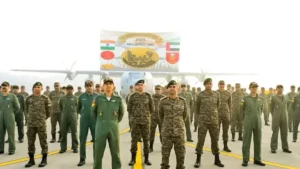United States has announced it will send the advanced THAAD missile defence system to Israel. This move is part of a broader strategy to bolster Israel’s defence capabilities and deter further aggression from Iran and other regional adversaries. The deployment underscores the US’s “ironclad commitment” to Israel’s defence and comes at a time of heightened geopolitical sensitivity in the region.
What is THAAD?
THAAD stands for Terminal High-Altitude Area Defense, a cutting-edge anti-ballistic missile defense system developed by Lockheed Martin Corporation. The system is designed to intercept and destroy enemy missiles in their final, or terminal phase, making it a critical asset for defending against missile threats.
A typical THAAD battery includes:
- 95 soldiers to operate and maintain the system
- Six truck-mounted launchers equipped with interceptors
- 48 interceptors (eight per launcher)
- Radar surveillance and detection systems
- A tactical fire control component
The system is highly mobile and can be quickly deployed to respond to short-range, medium-range, and limited intermediate-range ballistic missile threats, with ranges spanning from up to 1,000 km to 5,000 km. THAAD’s ability to target missiles both inside and outside the Earth’s atmosphere provides a distinct advantage over older systems like the Patriot Air and Missile Defense System.
How THAAD Works: Hit-to-Kill Technology
THAAD uses “hit-to-kill” technology, meaning it destroys incoming missiles by direct impact rather than using an explosive warhead. This approach enhances precision and minimizes collateral damage, making it an ideal defense mechanism against missiles carrying weapons of mass destruction.
The radar systems incorporated within THAAD are essential to detecting and tracking enemy missiles, providing real-time data to guide the interceptors. Once the missile is identified, the launchers deploy interceptors to destroy the threat before it reaches its target.
Why the Deployment of THAAD to Israel is Significant?
The decision to send THAAD to Israel marks a pivotal moment in US-Israel military cooperation. The US Department of Defense stated that this deployment is part of a series of military adjustments aimed at reinforcing Israel’s defense capabilities amidst growing threats from Iran and its aligned militias. The move not only boosts Israel’s defense against missile attacks but also signals a strong deterrence message to Iran and other hostile actors in the region.
Iran has warned the US against further involvement in West Asia, but the deployment of THAAD, along with US troops to operate it, indicates that the US is committed to ensuring Israel’s security. According to Iran’s Foreign Minister Abbas Araghchi, the US’s increased military presence in Israel is putting American lives at risk, but he emphasized that Iran has no “red lines” when defending its interests.
The THAAD system, with its cutting-edge technology, serves as a powerful deterrent to Iran’s aggression, particularly as Israel prepares to retaliate for a missile strike by Iran on October 1. US officials have reportedly urged Israel to show restraint, but the placement of the THAAD system in Israel reflects a precautionary measure to prevent further escalation.
US and Israel: A Strategic Military Alliance
The US-Israel military alliance is one of the strongest defense relationships in the world. The THAAD deployment underscores the US’s strategic interests in West Asia, particularly at a time when Iran has targeted Israel with missile attacks since the Gaza war erupted in October of last year. The defense of Israel remains a top priority for the US, and its allies have supported Israel in its efforts to combat these threats.
The deployment of THAAD is a step beyond typical defense measures. While Patriot systems have been in use for decades, THAAD represents a significant technological leap. Importantly, Ukraine has been requesting THAAD systems to defend itself against Russia, but the request has been denied due to the system’s operational complexity and the need for specialized US personnel.
The Cost and Complexity of THAAD
One of the reasons why THAAD has not been widely deployed around the world is its high cost and the requirement for US-trained personnel to operate the system. A single THAAD battery is estimated to cost around $2.5 billion, far exceeding the cost of a Patriot system, which is priced at approximately $1 billion per battery.
Moreover, deploying THAAD is not a simple matter of selling or gifting the system; it requires a trained crew to manage its intricate components, from launchers and interceptors to radar systems. This level of expertise further complicates its global distribution.
The Impact of THAAD on West Asia’s Geopolitical Landscape
The decision to deploy THAAD to Israel is likely to have ripple effects across West Asia. While Iran has already issued warnings, the presence of THAAD in Israel is expected to deter further missile strikes by demonstrating Israel’s enhanced defense capabilities. Additionally, it sends a clear message to Iran that the US will go to great lengths to protect its allies, even at the risk of heightened tensions in the region.
However, with Iran and the US both increasing their military presence in the region, the potential for an escalation in hostilities remains a concern. The ongoing diplomatic efforts to prevent a full-scale war will be critical in the coming weeks, especially as Israel considers retaliation for previous missile attacks.




 Exercise Desert Cyclone II Begins: India...
Exercise Desert Cyclone II Begins: India...
 Army Achieves Major Logistics Milestone ...
Army Achieves Major Logistics Milestone ...
 India and Brazil Sign Tripartite MoU on ...
India and Brazil Sign Tripartite MoU on ...







